亡灵节中英文介绍
- 格式:pptx
- 大小:12.39 MB
- 文档页数:13
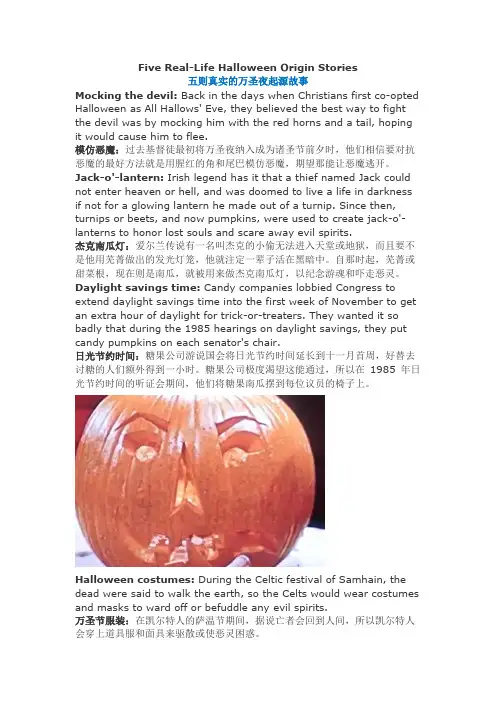
Five Real-Life Halloween Origin Stories五则真实的万圣夜起源故事Mocking the devil: Back in the days when Christians first co-opted Halloween as All Hallows' Eve, they believed the best way to fight the devil was by mocking him with the red horns and a tail, hoping it would cause him to flee.模仿恶魔:过去基督徒最初将万圣夜纳入成为诸圣节前夕时,他们相信要对抗恶魔的最好方法就是用腥红的角和尾巴模仿恶魔,期望那能让恶魔逃开。
Jack-o'-lantern: Irish legend has it that a thief named Jack could not enter heaven or hell, and was doomed to live a life in darkness if not for a glowing lantern he made out of a turnip. Since then, turnips or beets, and now pumpkins, were used to create jack-o'-lanterns to honor lost souls and scare away evil spirits.杰克南瓜灯:爱尔兰传说有一名叫杰克的小偷无法进入天堂或地狱,而且要不是他用芜菁做出的发光灯笼,他就注定一辈子活在黑暗中。
自那时起,芜菁或甜菜根,现在则是南瓜,就被用来做杰克南瓜灯,以纪念游魂和吓走恶灵。
Daylight savings time: Candy companies lobbied Congress to extend daylight savings time into the first week of November to get an extra hour of daylight for trick-or-treaters. They wanted it so badly that during the 1985 hearings on daylight savings, they put candy pumpkins on each senator's chair.日光节约时间:糖果公司游说国会将日光节约时间延长到十一月首周,好替去讨糖的人们额外得到一小时。
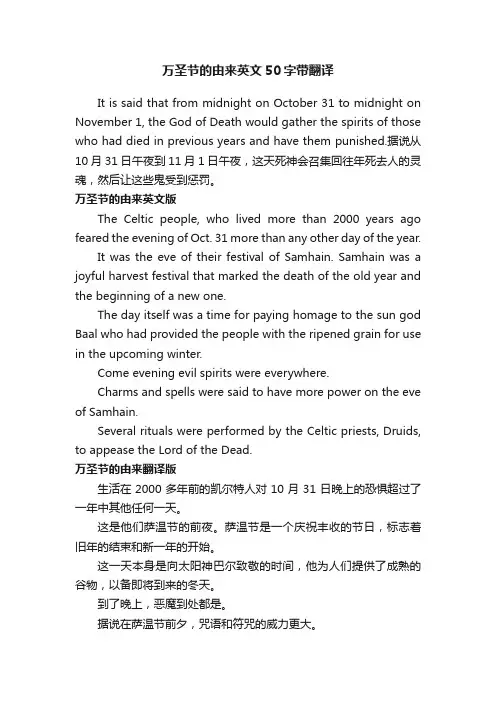
万圣节的由来英文50字带翻译It is said that from midnight on October 31 to midnight on November 1, the God of Death would gather the spirits of those who had died in previous years and have them punished.据说从10月31日午夜到11月1日午夜,这天死神会召集回往年死去人的灵魂,然后让这些鬼受到惩罚。
万圣节的由来英文版The Celtic people, who lived more than 2000 years ago feared the evening of Oct. 31 more than any other day of the year.It was the eve of their festival of Samhain. Samhain was a joyful harvest festival that marked the death of the old year and the beginning of a new one.The day itself was a time for paying homage to the sun god Baal who had provided the people with the ripened grain for use in the upcoming winter.Come evening evil spirits were everywhere.Charms and spells were said to have more power on the eve of Samhain.Several rituals were performed by the Celtic priests, Druids, to appease the Lord of the Dead.万圣节的由来翻译版生活在2000多年前的凯尔特人对10月31日晚上的恐惧超过了一年中其他任何一天。
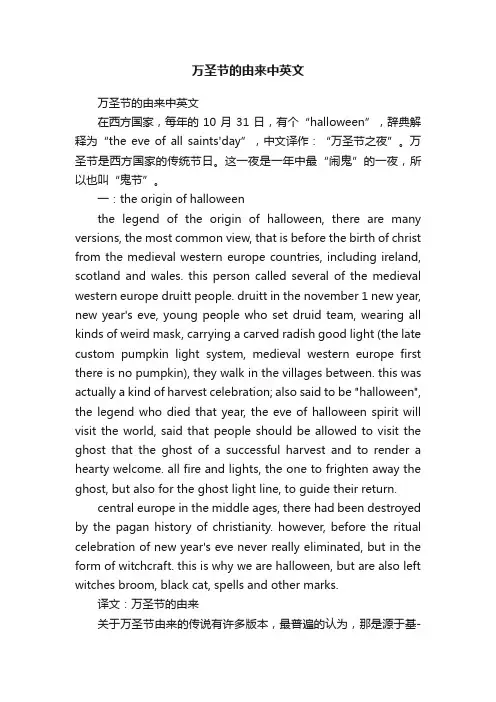
万圣节的由来中英文万圣节的由来中英文在西方国家,每年的10月31日,有个“halloween”,辞典解释为“the eve of all saints'day”,中文译作:“万圣节之夜”。
万圣节是西方国家的传统节日。
这一夜是一年中最“闹鬼”的一夜,所以也叫“鬼节”。
一:the origin of halloweenthe legend of the origin of halloween, there are many versions, the most common view, that is before the birth of christ from the medieval western europe countries, including ireland, scotland and wales. this person called several of the medieval western europe druitt people. druitt in the november 1 new year, new year's eve, young people who set druid team, wearing all kinds of weird mask, carrying a carved radish good light (the late custom pumpkin light system, medieval western europe first there is no pumpkin), they walk in the villages between. this was actually a kind of harvest celebration; also said to be "halloween", the legend who died that year, the eve of halloween spirit will visit the world, said that people should be allowed to visit the ghost that the ghost of a successful harvest and to render a hearty welcome. all fire and lights, the one to frighten away the ghost, but also for the ghost light line, to guide their return.central europe in the middle ages, there had been destroyed by the pagan history of christianity. however, before the ritual celebration of new year's eve never really eliminated, but in the form of witchcraft. this is why we are halloween, but are also left witches broom, black cat, spells and other marks.译文:万圣节的由来关于万圣节由来的传说有许多版本,最普遍的认为,那是源于基-督诞生前的古西欧国家,主要包括爱尔兰、苏格兰和威尔士。
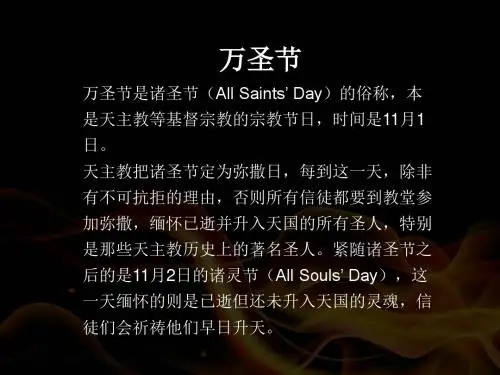

亡灵节中英文介绍2020
亡灵节(Day of the Dead)是一个传统节日,主要在墨西哥和
中美洲地区庆祝。
这个节日的目的是纪念已经离世的家人和朋友,并想象他们的灵魂回到人间参与这个节日庆祝。
亡灵节通常在11月1日和2日庆祝。
11月1日是为亡灵的儿
童准备的,而11月2日是为成年人准备的。
节日期间,人们
会准备美食、花环、烛光和祷告用品,并在墓地和家庭中心设置祭坛,用来纪念亡灵。
墓地是亡灵节的重要地点,人们会在墓前祷告,并为逝者准备他们最喜欢的食物和饮料。
在家庭祭坛上,人们用彩色小纸花、骨头模型、糖果头骨和其他装饰品来热情欢迎亡灵的灵魂。
除了亡灵节,一些墨西哥和中美洲国家还会在万圣节前夕庆祝“巫婆节”(La Noche de Brujas)和“万圣日”(All Saints’ Day),这些节日也与纪念亡灵和祖先有关。
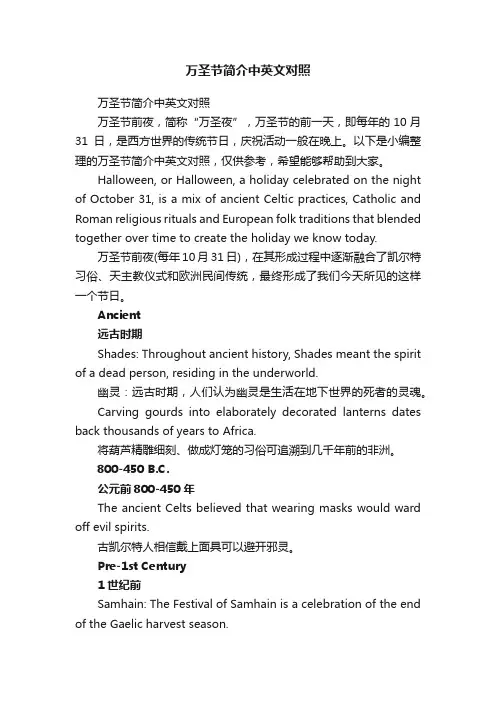
万圣节简介中英文对照万圣节简介中英文对照万圣节前夜,简称“万圣夜”,万圣节的前一天,即每年的10月31日,是西方世界的传统节日,庆祝活动一般在晚上。
以下是小编整理的万圣节简介中英文对照,仅供参考,希望能够帮助到大家。
Halloween, or Halloween, a holiday celebrated on the night of October 31, is a mix of ancient Celtic practices, Catholic and Roman religious rituals and European folk traditions that blended together over time to create the holiday we know today.万圣节前夜(每年10月31日),在其形成过程中逐渐融合了凯尔特习俗、天主教仪式和欧洲民间传统,最终形成了我们今天所见的这样一个节日。
Ancient远古时期Shades: Throughout ancient history, Shades meant the spirit of a dead person, residing in the underworld.幽灵:远古时期,人们认为幽灵是生活在地下世界的死者的灵魂。
Carving gourds into elaborately decorated lanterns dates back thousands of years to Africa.将葫芦精雕细刻、做成灯笼的习俗可追溯到几千年前的非洲。
800-450 B.C.公元前800-450年The ancient Celts believed that wearing masks would ward off evil spirits.古凯尔特人相信戴上面具可以避开邪灵。
Pre-1st Century1世纪前Samhain: The Festival of Samhain is a celebration of the end of the Gaelic harvest season.死神节:盖尔人(苏格兰和爱尔兰的凯尔特人)庆祝丰收季节结束的节日。
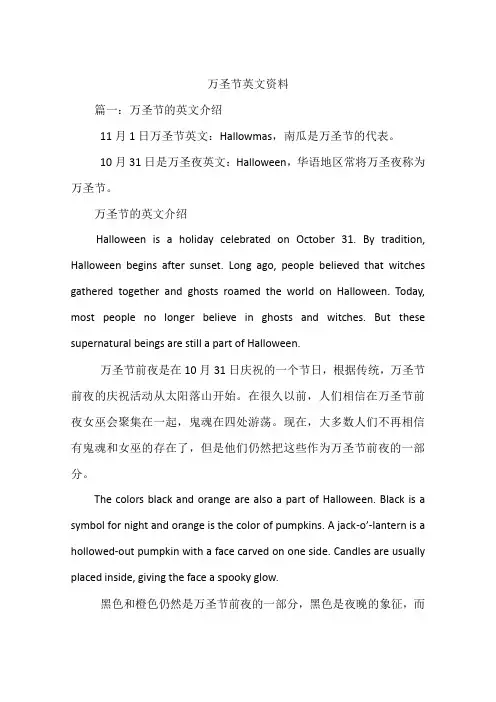
万圣节英文资料篇一:万圣节的英文介绍11月1日万圣节英文:Hallowmas,南瓜是万圣节的代表。
10月31日是万圣夜英文:Halloween,华语地区常将万圣夜称为万圣节。
万圣节的英文介绍Halloween is a holiday celebrated on October 31. By tradition, Halloween begins after sunset. Long ago, people believed that witches gathered together and ghosts roamed the world on Halloween. Today, most people no longer believe in ghosts and witches. But these supernatural beings are still a part of Halloween.万圣节前夜是在10月31日庆祝的一个节日,根据传统,万圣节前夜的庆祝活动从太阳落山开始。
在很久以前,人们相信在万圣节前夜女巫会聚集在一起,鬼魂在四处游荡。
现在,大多数人们不再相信有鬼魂和女巫的存在了,但是他们仍然把这些作为万圣节前夜的一部分。
The colors black and orange are also a part of Halloween. Black is a symbol for night and orange is the color of pumpkins. A jack-o’-lantern is a hollowed-out pumpkin with a face carved on one side. Candles are usually placed inside, giving the face a spooky glow.黑色和橙色仍然是万圣节前夜的一部分,黑色是夜晚的象征,而橙色代表着南瓜。
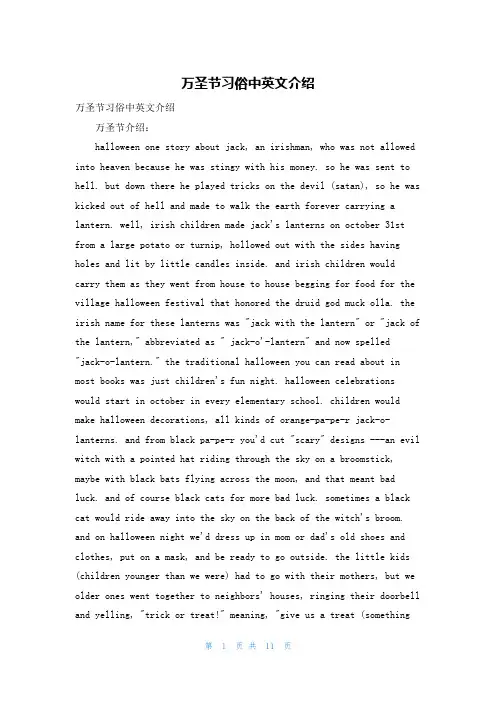
万圣节习俗中英文介绍万圣节习俗中英文介绍万圣节介绍:halloween one story about jack, an irishman, who was not allowed into heaven because he was stingy with his money. so he was sent to hell. but down there he played tricks on the devil (satan), so he was kicked out of hell and made to walk the earth forever carrying a lantern. well, irish children made jack's lanterns on october 31st from a large potato or turnip, hollowed out with the sides having holes and lit by little candles inside. and irish children would carry them as they went from house to house begging for food for the village halloween festival that honored the druid god muck olla. the irish name for these lanterns was "jack with the lantern" or "jack of the lantern," abbreviated as " jack-o'-lantern" and now spelled "jack-o-lantern." the traditional halloween you can read about in most books was just children's fun night. halloween celebrations would start in october in every elementary school. children would make halloween decorations, all kinds of orange-pa-pe-r jack-o-lanterns. and from black pa-pe-r you'd cut "scary" designs ---an evil witch with a pointed hat riding through the sky on a broomstick, maybe with black bats flying across the moon, and that meant bad luck. and of course black cats for more bad luck. sometimes a black cat would ride away into the sky on the back of the witch's broom. and on halloween night we'd dress up in mom or dad's old shoes and clothes, put on a mask, and be ready to go outside. the little kids (children younger than we were) had to go with their mothers, but we older ones went together to neighbors' houses, ringing their doorbell and yelling, "trick or treat!" meaning, "give us a treat (somethingto eat) or we'll play a trick on you!" the people inside were supposed to come to the door and comment on our costumes. oh! here's a ghost. oh, there's a witch. oh, here's an old lady. sometimes they would play along with us and pretend to be scared by some ghost or witch. but they would always have some candy and maybe an apple to put in our "trick or treat bags." but what if no one come to the door, or if someone chased us away? then we'd play a trick on them, usually taking a piece of soap and make marks on their windows. .and afterwards we would go home and count who got the most candy. one popular teen-agers' halloween trick was to unroll a roll of toiletpa-pe-r and throw it high into a tree again and again until the tree was all wrapped in the white pa-pe-r. the pa-pe-r would often stay in the tree for weeks until a heavy snow or rain washed it off. no real harm done, but it made a big mess of both the tree and the yard under it. one kind of halloween mischief.万圣节是西方的鬼节在西方国家,每年的10月31日,有个“halloween”,辞典解释为“the eve of all saints'day”,中文译作:“万圣节之夜”。
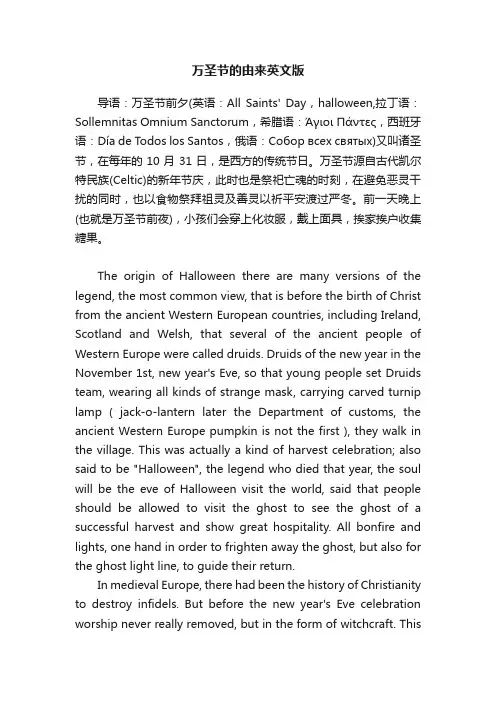
万圣节的由来英文版导语:万圣节前夕(英语:All Saints' Day,halloween,拉丁语:Sollemnitas Omnium Sanctorum,希腊语:ΆγιοιΠάντες,西班牙语:Día de Todos los Santos,俄语:Собор всех святых)又叫诸圣节,在每年的10月31日,是西方的传统节日。
万圣节源自古代凯尔特民族(Celtic)的新年节庆,此时也是祭祀亡魂的时刻,在避免恶灵干扰的同时,也以食物祭拜祖灵及善灵以祈平安渡过严冬。
前一天晚上(也就是万圣节前夜),小孩们会穿上化妆服,戴上面具,挨家挨户收集糖果。
The origin of Halloween there are many versions of the legend, the most common view, that is before the birth of Christ from the ancient Western European countries, including Ireland, Scotland and Welsh, that several of the ancient people of Western Europe were called druids. Druids of the new year in the November 1st, new year's Eve, so that young people set Druids team, wearing all kinds of strange mask, carrying carved turnip lamp ( jack-o-lantern later the Department of customs, the ancient Western Europe pumpkin is not the first ), they walk in the village. This was actually a kind of harvest celebration; also said to be "Halloween", the legend who died that year, the soul will be the eve of Halloween visit the world, said that people should be allowed to visit the ghost to see the ghost of a successful harvest and show great hospitality. All bonfire and lights, one hand in order to frighten away the ghost, but also for the ghost light line, to guide their return.In medieval Europe, there had been the history of Christianity to destroy infidels. But before the new year's Eve celebration worship never really removed, but in the form of witchcraft. Thisis why we are Halloween, also left the witch's broom, black cat, spells and other traces.The history of Halloween two legend:The firstTwo thousand years ago, Europe's Catholic Church would make November 1st as " All Hallows Day" ( ALL HALLOWS DAY ). " HALLOW" the saints. Legend since five hundred BC, living in Ireland, Scotland and other places of the Celtic ( CELTS ) moved forward this festive day, October 31st. They feel that the day is the formal end of the summer days, it is at the beginning of the year, the harsh winter, the day began. When people believe in, the spirits of the enemy on this day back in the house to find him in the living creatures, to regeneration, and it is people can be reborn after the death of the only hope. The living dead who are afraid to come to seize the soul of health, so people will put out the fire on this day, candlelight, let the soul can not find the living dead, also dressed up as demons and ghosts to scare away the dead souls. After that, they will rekindle the fire candle to, the beginning of the new year of life. Fable Celts tribe also had at that time in October 31st to pay homage to the dead to kill the living custom.In the first Century, Celtic tribes occupied the territory of the Roman people have gradually accepted the Halloween customs, but has since abolished the firing of brutal practices of the living dead festival. Romans celebrate the harvest festival with the Celtics ceremony, wearing a frightening mask, dressed in animal or ghosts, are intended to drive away demons wandering around in their. This is what most people in today's global ancient spirit demon dressed, to celebrate the origin of halloween. As time goes by, the meaning of Halloween has changed gradually,become active happy, happy has become a mainstream means. The dead soul back to look for a substitute to say the world has gradually been abandoned and forgotten. T o this day, a symbol of Halloween images, such as witches, black cats, picture, is mostly friendly cute and funny face.The second kindLegends about the origin of Halloween another version of that, it was before the birth of Christ from the ancient Western European countries, including Ireland, Scotland and Welsh. That several of the ancient people of Western Europe were called druids. Druids of the new year in the November 1st, new year's Eve, so that young people set Druids team, wearing all kinds of strange mask, carrying carved turnip lamp ( jack-o-lantern later the Department of customs, the ancient Western Europe pumpkin is not the first ), they walk in the village. This was actually a kind of harvest celebration; also said to be "Halloween", the legend who died that year, the soul will be the eve of Halloween visit the world, said that people should be allowed to visit the ghost to see the ghost of a successful harvest and show great hospitality. All bonfire and lights, one hand in order to frighten away the ghost, but also for the ghost light line, to guide their return.In medieval Europe, there had been the history of Christianity to destroy infidels. But before the new year's Eve celebration worship never really removed, but in the form of witchcraft. This is why we are Halloween, also left the witch's broom, black cat, spells and other traces.关于万圣节由来的传说有许多版本,最普遍的认为,那是源于基督诞生前的古西欧国家,主要包括爱尔兰、苏格兰和威尔士,这几处的古西欧人叫德鲁伊特人.德鲁伊特的新年在十一月一日,新年前夜,德鲁伊特人让年轻人集队,戴着各种怪异面具,拎着刻好的萝卜灯(南瓜灯系后期习俗,古西欧最早没有南瓜),他们游走于村落间.这在当时实则为一种秋收的庆典;也有说是“鬼节”,传说当年死去的人,灵魂会在万圣节的前夜造访人世,据说人们应该让造访的鬼魂看到圆满的收成并对鬼魂呈现出丰盛的款待.所有篝火及灯火,一来为了吓走鬼魂,同时也为鬼魂照亮路线,引导其回归.在中世纪的中欧,曾有过基督教摧毁异教徒的历史.可是新年夜前的祭祀庆典从未真正消除,不过以巫术的形式出现.这也就是为什么我们现在的万圣节里,还留有巫婆的扫帚、黑猫、咒语等痕迹.万圣节的来历的两种传说:第一种两千多年前,欧洲的天主教会把11月1日定为“天下圣徒之日” (ALL HALLOWS DAY) .“HALLOW” 即圣徒之意.传说自公元前五百年,居住在爱尔兰、苏格兰等地的凯尔特人(CELTS)把这节日往前移了一天,即10月31日.他们认为该日是夏天正式结束的日子,也就是新年伊始,严酷的冬季开始的一天.那时人们相信,故人的亡魂会在这一天回到故居地在活人身上找寻生灵,借此再生,而且这是人在死后能获得再生的唯一希望.而活着的人则惧怕死魂来夺生,于是人们就在这一天熄掉炉火、烛光,让死魂无法找寻活人,又把自己打扮成妖魔鬼怪把死人之魂灵吓走.之后,他们又会把火种烛光重新燃起,开始新的一年的生活.传说那时凯尔特人部落还有在10月31日把活人杀死用以祭奠死人的习俗.到了公元1世纪,占领了凯尔特部落领地的罗马人也渐渐接受了万圣节习俗,但从此废止了烧活人祭死人的野蛮做法.罗马人庆祝丰收的节日与凯尔特人仪式结合,戴着可怕的面具,打扮成动物或鬼怪,则是为了赶走在他们四周游荡的妖魔.这也就是今天全球大部分人以古灵精怪的打扮,来庆祝万圣节的由来.时间流逝,万圣节的意义逐渐起了变化,变得积极快乐起来,喜庆的意味成了主流.死魂找替身返世的说法也渐渐被摒弃和忘却.到了今天,象征万圣节的形象、图画如巫婆、黑猫等,大都有友善可爱和滑稽的脸.第二种关于万圣节由来的传说另一种版本认为,那是源于基督诞生前的古西欧国家,主要包括爱尔兰、苏格兰和威尔士.这几处的古西欧人叫德鲁伊特人.德鲁伊特的新年在11月1日,新年前夜,德鲁伊特人让年轻人集队,戴着各种怪异面具,拎着刻好的萝卜灯(南瓜灯系后期习俗,古西欧最早没有南瓜),他们游走于村落间.这在当时实则为一种秋收的庆典;也有说是“鬼节”,传说当年死去的人,灵魂会在万圣节的前夜造访人世,据说人们应该让造访的鬼魂看到圆满的收成并对鬼魂呈现出丰盛的款待.所有篝火及灯火,一来为了吓走鬼魂,同时也为鬼魂照亮路线,引导其回归.在中世纪的中欧,曾有过基督教摧毁异教徒的历史.可是新年夜前的祭祀庆典从未真正消除,不过以巫术的形式出现.这也就是为什么我们现在的万圣节里,还留有巫婆的扫帚、黑猫、咒语等痕迹.。
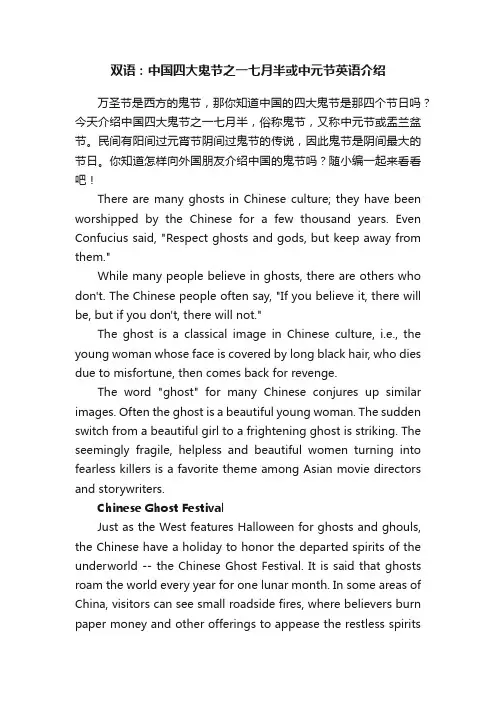
双语:中国四大鬼节之一七月半或中元节英语介绍万圣节是西方的鬼节,那你知道中国的四大鬼节是那四个节日吗?今天介绍中国四大鬼节之一七月半,俗称鬼节,又称中元节或盂兰盆节。
民间有阳间过元宵节阴间过鬼节的传说,因此鬼节是阴间最大的节日。
你知道怎样向外国朋友介绍中国的鬼节吗?随小编一起来看看吧!There are many ghosts in Chinese culture; they have been worshipped by the Chinese for a few thousand years. Even Confucius said, "Respect ghosts and gods, but keep away from them."While many people believe in ghosts, there are others who don't. The Chinese people often say, "If you believe it, there will be, but if you don't, there will not."The ghost is a classical image in Chinese culture, i.e., the young woman whose face is covered by long black hair, who dies due to misfortune, then comes back for revenge.The word "ghost" for many Chinese conjures up similar images. Often the ghost is a beautiful young woman. The sudden switch from a beautiful girl to a frightening ghost is striking. The seemingly fragile, helpless and beautiful women turning into fearless killers is a favorite theme among Asian movie directors and storywriters.Chinese Ghost FestivalJust as the West features Halloween for ghosts and ghouls, the Chinese have a holiday to honor the departed spirits of the underworld -- the Chinese Ghost Festival. It is said that ghosts roam the world every year for one lunar month. In some areas of China, visitors can see small roadside fires, where believers burn paper money and other offerings to appease the restless spiritsthat have temporarily been released from Hades.The Chinese Ghost Festival is also called "Half July" (Lunar). It is a popular occasion celebrated throughout China on the 15th day of the seventh lunar month.Historically, families offer sacrifices of the newly harvested grain to departed ancestors on this day, which also coincides with the Buddhist Ullambana (Deliverance) Festival and the Taoist Chinese Ghost Festival. Since each of these traditions in some way honors the spirits of the departed, the seventh lunar month has come to be known as "Ghost Month" and is a time when the "Good Brethren" (ghosts from the underworld) come back to earth to feast on the victuals offered by the living. Over time the Ullambana Festival and Ghost Festival have melded together to become the present-day Chung Yuan Putu or "Mid-origin Passage to Universal Salvation."The Chinese believe that the dead become ghosts between heaven and earth. Spirits without descendants to care for them are summoned during the Ghost Festival so that they may also enjoy the warmth of life among the living. This custom -- an extension of the traditional Chinese ethic of "universal love" -- has been woven together with the didactic legend, "Moginlin Saving His Mother From Hades." It lends the Ghost Festival a positive spin as a time for remembering the importance of filial piety. People now have inherited releasing river light as an important activity. It is said that river light can comfort and warm homeless ghosts.Burial of the deadIn the past, the burial of the dead (cremation is traditionally uncommon) was a matter taken very seriously in Chinese society. Improper funeral arrangements could wreak ill fortune anddisaster upon the family of the deceased.To a certain degree, Chinese funeral rites and burial customs were determined by the age of the deceased, the manner of his/her death, his/her status and position in society and his/her marital status.According to Chinese custom, an older person should not show respect to someone younger. Thus, if the deceased was a young bachelor his body could not be brought home but was left at the funeral parlor and the parents could not offer prayers for their son. Since the deceased was unmarried he had no children to perform the rites, which was why the body did not enter the family home. If a baby or child died no funeral rites were performed since respect could not be shown to a younger person. The child was, therefore, buried in silence.Chinese funeral rites for an elderly person must follow the prescribed form and convey the relevant rites that befit the person.Chinese thoughts towards life after deathYoung women in traditional societies are rarely endowed with much power, and malignant powers are only summoned with keen hatred and a desire for revenge. The more badly one is wronged, the more powerful he or she becomes after death.Such beliefs are closely related to the Chinese attitude towards life after death -- a combination of superstition and religion.Buddhist doctrines about the life cycle led to many vivid descriptions in Chinese legends about karma. For example, Buddhism forbids murder; in folklore, people believe that butchers return in the next life in the form of the animals they killed. People who treat others badly or do cruel things becomepathetic beings, suffering for the rest of the next life.Besides retribution in lives to come, vivid and complicated descriptions of heaven and hell also exist in Chinese legends.People have imaginatively transfigured their real life experiences into visions of the unknown world. The Chinese legendary hell, for example, is governed by a king in a completely bureaucratic system.The king of the underground takes charge of people's lives, keeping a book that spells out the exact time of everybody's death.In the classic novel, Pilgrimage to the West, the Monkey King Wu Kong goes to visit the king of hell and reads the book of death. He looks for his own name and erases it, ensuring himself everlasting life.。
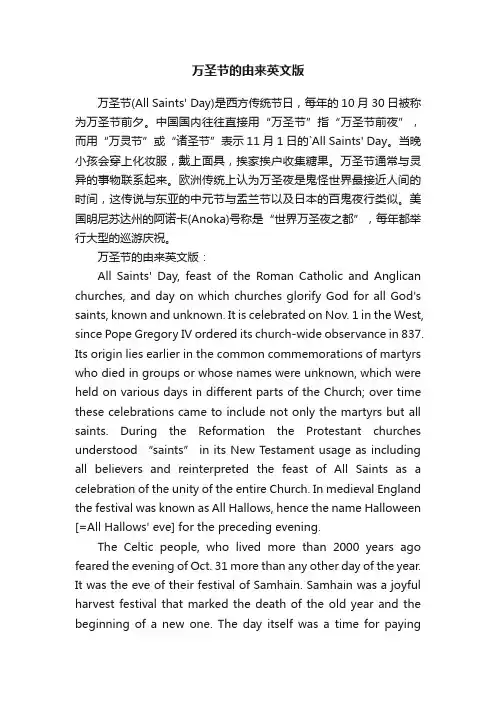
万圣节的由来英文版万圣节(All Saints' Day)是西方传统节日,每年的10月30日被称为万圣节前夕。
中国国内往往直接用“万圣节”指“万圣节前夜”,而用“万灵节”或“诸圣节”表示11月1日的`All Saints' Day。
当晚小孩会穿上化妆服,戴上面具,挨家挨户收集糖果。
万圣节通常与灵异的事物联系起来。
欧洲传统上认为万圣夜是鬼怪世界最接近人间的时间,这传说与东亚的中元节与盂兰节以及日本的百鬼夜行类似。
美国明尼苏达州的阿诺卡(Anoka)号称是“世界万圣夜之都”,每年都举行大型的巡游庆祝。
万圣节的由来英文版:All Saints' Day, feast of the Roman Catholic and Anglican churches, and day on which churches glorify God for all God's saints, known and unknown. It is celebrated on Nov. 1 in the West, since Pope Gregory IV ordered its church-wide observance in 837. Its origin lies earlier in the common commemorations of martyrs who died in groups or whose names were unknown, which were held on various days in different parts of the Church; over time these celebrations came to include not only the martyrs but all saints. During the Reformation the Protestant churches understood “saints” in its New Testament usage as including all believers and reinterpreted the feast of All Saints as a celebration of the unity of the entire Church. In medieval England the festival was known as All Hallows, hence the name Halloween [=All Hallows' eve] for the preceding evening.The Celtic people, who lived more than 2000 years ago feared the evening of Oct. 31 more than any other day of the year. It was the eve of their festival of Samhain. Samhain was a joyful harvest festival that marked the death of the old year and the beginning of a new one. The day itself was a time for payinghomage to the sun god Baal who had provided the people with the ripened grain for use in the upcoming winter. Come evening evil spirits were everywhere. Charms and spells were said to have more power on the eve of Samhain. Several rituals were performed by the Celtic priests, Druids, to appease the Lord of the Dead.Halloween was called Samhain by the Irish. It came to be known as Halloween sometime around the fifth century A.D. .Samhain took place on October 31 through to November 1. During this period, it was believed that the boundaries between our world and the world of the dead were weakened, allowing spirits of the recently dead to cross over and possess the living.To celibrate the festival, the Irish would dress up in bizarre costumes and parade through their villages,causing destruction and saying "Trick-or-Treat", in order to scare off any recently departed souls who might be prowling for bodies to inhabit.This yearly festival was later brought to the other regions of the world, including continental Europe and North America. Irish immigrants brought several customs with them, including one of the symbols most commonly associated with Halloween -- the "Jack Lantern".According to Irish folklore, there once lived a man named Jack who was known for being a drunk and a prankster. One night Jack tricked the devil into climbing a tree, and quickly carved an image of a cross on the trunk, trapping the devil. Jack then made him promise that, in exchange for letting him out of the tree, the Devil would never tempt him to sin again. He reluctantly agreed, but was able to exact his revenge upon Jack's death. Because of his mischievous ways in life, Jack was barred from enteringheaven and because of his earlier trick; he was also barred from hell. So he was doomed to wander the earth until the end of time, with only a "Jack Lanterns" to warm him.In Ireland, they originally used turnips for their "Jack Lanterns", but upon arriving in north America, they discovered that pumpkins were abundant and easier to carve out.。
October 31On October 31st, dozens of children dressed in costumes(节日服装)knock on their neighbors' doors and yell "Trick or Treat" when the door opens. Pirates and princesses, ghosts and popular heroes of the day all hold bags open to catch the candy or other goodies that the neighbors drop in. As they give each child a treat the neighbors exclaim over the costumes and try to guess who is under the masks.Since the 800's November 1st is a religious holiday known as All Saints' Day(万圣节). The Mass that was said on this day was called Allhallowmas. The evening before became known as All Hakkiw e'en, or Halloween. Like some other American celebrations, its origins lie in both pre-Christian and Christian customs.October 31 st was the eve of the Celtic(凯尔特人的)new year. The Celts were the ancestors of the present-day Irish, Welsh and Scottish people. On this day ghosts walked and mingled with the living, or so the Celts thought. The townspeople baked food all that day and when night fell they dressed up and tried to resemble the souls of the dead. Hoping that the ghosts would leave peacefully before midnight of the new year.Much later, when Christianity spread throughout Ireland and October 31 was no longer the last day of the year, Halloween became a celebration mostly for children. "Ghosts" went from door to door asking for treats, or else a trick would be played on the owners of the house. When millions of Irish people immigrated to the United States in the 1840s the tradition came with them.Today' school dances and neighborhood parties called "block parties" are popular among young andold alike. More and more adults celebrate Halloween. They dress up like historical or political figures and go to masquerade parties(化妆舞会). In larger cities, costumed children and their parents gather at shopping malls early in the evening. Stores and businesses give parties with games and treats for the children.Teenagers enjoy costume dances at their schools and the more outrageous the costume the better!Certain pranks(恶作剧)such as soaping car windows and tipping over garbage cans are expected. But partying and pranks are not the only things that Halloweeners enjoy doing. Some collect money to buy food and medicine for needy children around the world.Symbols of HalloweenHalloween originated as a celebration connected with evil spirits. Witches flying on broomsticks with black cats, ghosts, goblins(小精灵)and skeletons have all evolved as symbols of Halloween. They are popular trick-or-treat costumes and decorations for greeting cards and windows. Black is one of the traditional Halloween colors, probably because Halloween festivals and traditions took place at night. In the weeks before October 31, Americans decorate windows of houses and schools with silhouettes(轮廓)of witches and black cats.Pumpkins are also a symbol of Halloween. The pumpkin is an orange-colored squash, and orange has become the other traditional Halloween color. Carving pumpkins into jack- o'lanterns is a Halloween custom also dating back to Ireland. A legend grew up about a man named Jack who was so stingy(吝啬的)that he was not allowed into heaven when he died, because he was a miser(吝啬鬼). He couldn't enter hell either because he had played jokes on the devil. As a result, Jack had to walk the earth with hislantern until Judgement Day(审判日). The Irish people carved scary faces out of turnips(芜菁根),beets(甜菜根)or potatoes representing "Jack of the Lantern," or Jack-o'lantern. When the Irish brought their customs to the United States, they carved faces on pumpkins because in the autumn they were more plentiful than turnips. Today jack-o'-lanterns in the windows of a house on Halloween night let costumed children know that there are goodies(糖果)waiting if they knock and say "Trick or Treat!"Halloween TreatsDried Pumpkin SeedsAfter carving your pumpkin, separate the pulp from the seeds. Rinse(冲洗)the seeds and spread them out to dry. The next day, add enough melted butter or margarine(人造黄油)to coat each seed. Spread the seeds onto a cookie sheet(甜酥饼干)and bake for 20 minutes in a 300 degree oven for 20 minutes or until they are slightly brown.Caramel ApplesTake the paper wrapping off about 100 caramels(饴糖)and put them in a saucepan(炖锅). Put the saucepan over a pan of boiling water. Boil the water until the caramels melt. Put a wooden stick into the top of each apple, dip the apple into the caramel. Let them cool on wax paper and enjoy!Scary StoriesNo Halloween party is complete without at least one scary story. Usually one person talks in a low voice while everyone else crowds together on the floor or around a fire. The following is a retelling of a tale told in Britain and in North Carolina and Virginia."What Do You Come For?"There was an old woman who lived all by herself, and she was very lonely. Sitting in the kitchen one night, she said, "Oh, I wish I had some company."No sooner had she spoken than down the chimney tumbled two feet from which the flesh had rotted. The old woman's eyes bulged with terror.Then two legs dropped to the hearth and attached themselves to the feet.Then a body tumbled down, then two arms, and a man's head.As the old woman watched, the parts came together into a great, tall man. The man danced around and around the room. Faster and faster he went. Then he stopped, and he looked into her eyes."What do you come for? she asked in a small voice that shivered and shook."What do I come for?" he said. "I come for YOU!"The narrator shouts and jumps at the person near him!汉译10 月31 日10 月31 日,数十名身穿服装(节日服装)的儿童敲他们的邻居门并大声喊着"捣乱"门打开时。
中国鬼节节英文介绍第一篇:中国鬼节节英文介绍目连救母:有一个叫目连的僧人,他的母亲堕落于饿鬼道中,食物入口就会化成一团火焰,整天忍受着饥饿的痛苦,目连无法解救他的母亲,于是向佛祖求救,佛给他一本盂兰盆经,让他在七月十五作盂兰盆来解救他的母亲。
以后传承开来,成了盂兰盆的传统。
因此盂兰盆节强调的是孝道。
There is a named Mulian monk , his mother has fallen to hungry ghosts, the entrance of food will be turned into a flame, all day long endure hunger, Mulian unable to save his mother, then to Buddha for help, the Buddha gave a MU lan pen jing, let him in July fifteen as MU lan pen jing to save his mother.After passing away, the Bon tradition.Therefore the Obon is emphasized filial piety寒衣节;孟姜女千里送寒衣:古代有一位孟先生家中生长有一串葫芦,藤蔓生长到隔壁结了一个大葫芦,两户人协商将葫芦平分,然而,有一个女孩在葫芦里面,两家取名为孟姜女,当孟姜女16岁时遇到范喜良两人结为夫妻,但是在结婚之时,范喜良被兵抓去修建长城,活活累死,孟姜女在冬天思恋丈夫,便去为千里之外的丈夫送衣服,不料丈夫已经死去,她放声大哭,大海上的波涛将一段长城摧毁,露出一具具骸骨,孟姜女哭了七天七夜,将寒衣烧掉,覆盖到了白骨之上。
Winter clothing festival;Meng Jiangnu send thousands of miles winter coat: In ancient times there was a Mr.Meng home is a gourd vine growth, growth to the next node a big calabash gourd, two people consultation(协商)will be equally, however, there is a girl in hyacinth, both named Meng Jiangnu, when MengJiangnu was 16 years old when he met Fan Xiliang in two married, but the marriage is, Fan Xiliang was caught to build the Great Wall of soldiers, to death in the winter, Meng Jiangnu thinks her husband, went for a thousand miles husband send clothes, but he was dead, she burst into tears, sea waves will destroy the exposed section of the Great Wall, a skeleton, Meng Jiangnu wept for seven days and nights of winter clothing, will burn, covered the bones.1、Qing Ming Jie(All Souls' Day/Tomb-Sweeping Day/Pure Brightness Day)Qing Ming is a time to remember the dead and the dearly departed(离去,死者).More important, it is a period to honour and to pay respect to one's deceased(死者,已故的)ancestors and family members.Because it reinforces(加强,加固;强化;补充)the ethic(伦理;道德规范)of filial(孝顺的;子女的)piety (虔诚;孝敬;虔诚的行为或语言), Qing Ming is a major Chinese festival.Literally(照字面地)meaning “clear”(Qing)and “bright”(Ming), this Chinese fe stival falls in early spring, on the 106th day after the winter solstice(冬至).It is a “spring” festival, and it is an occasion for the whole family to leave the home and to sweep the graves of their forebears(祖先).Chinese being practical people this sweeping of the graves is given an extended period, that is, 10 days before and after Qing Ming day.Among some dialect(方言,土话)groups a whole month is allocated(分配的,指派的).清明节是一个纪念祖先的节日。